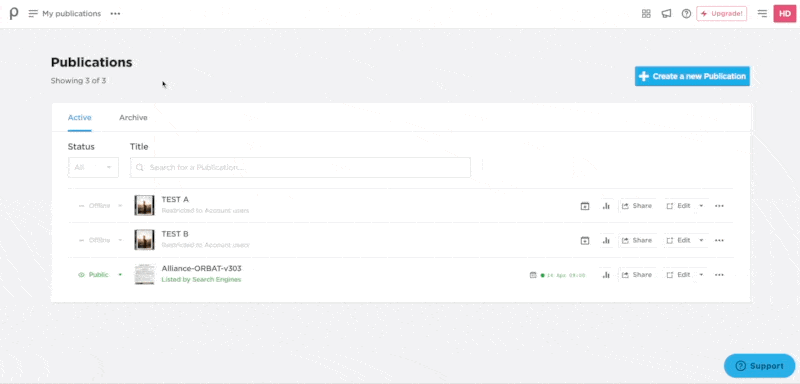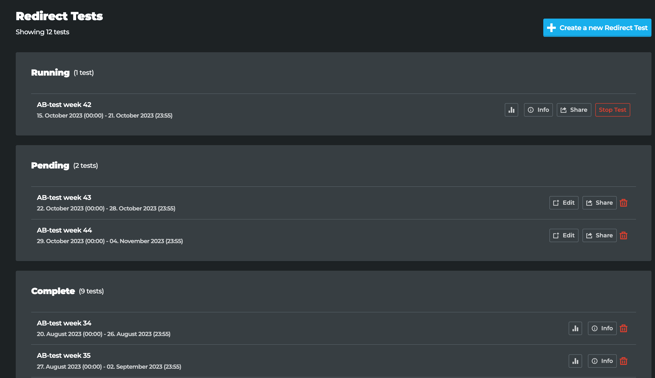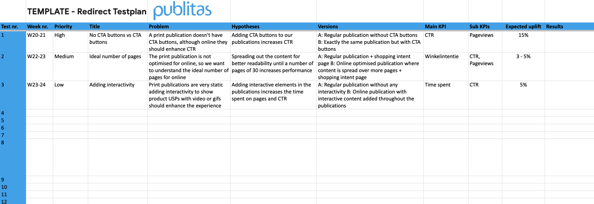A/B or Redirect testing in Publitas
EARLY ACCESS: Reach out to to your Success Manager if you're interested in optimizing your content in a data-driven manner.
---
In this article:
- Definition of a redirect test
- How to set up a redirect test
- What URLs to communicate
- Do's and don'ts
- Analyzing redirect test results
What is a redirect test?
A redirect test is a type of A/B test that allows you to test different publication designs against each other. By continuously testing and learning from different variants, you can make data-driven decisions to optimize your content and improve its effectiveness.
How to set up a redirect test within Publitas
To take advantage of redirect testing in Publitas, follow these steps:
- Request enabling the redirect testing feature: Contact your Publitas representative or support team and ask them to enable the redirect testing feature for your account. Once it's enabled, you'll be able to access this powerful functionality.
- Create two or more versions of your publication (original + variant(s)): When setting up a redirect test, it's crucial to have two distinct versions of your publication. Make sure to give them different names to make it easier to track the results. This works for both embedded and stand-alone publications.
- Navigate to redirect testing in the group menu: Click on the three dots next to your group name to navigate to the redirect testing page
- Set up the test publications: Add the original publication and at least one variant publication.
- Configure the timings of your redirect test: You can select the timing for when your test needs to run. The timezone used is the one set in your group settings. Press 'Save'. That's it!

Once the test is set to go live, you will see it move from the 'Pending' section to the 'Running' section and, when complete, to the 'Complete' section. From the Running phase, you'll be able to access the data by selecting the bar chart icon.

Publishing your publication from which the test will run
The URL you need to publish is the same as the original publication URL. You can find it in the 'Share' button on the redirect page of a pending test or directly as you usually do on the publication list 'Share' button. No changes here - it's the same link!
If you are using the group URL, the latest online publication will be automatically published, so ensure that your original publication for the Redirect or A/B test is the last one to go online.
What link to share in your marketing campaigns?
Continue to share the same link you use on your site, whether the original publication URL or the group URL.
What status to place your publications on?
We recommend moving or scheduling the original publication URL to go 'public' for the start of the test and the variant to remain unlisted so it does not get tracked by search engines but is still live for part of the audience to be able to access during the test.
Be aware if you have any API automation in place based on publication status to ensure no surprises! If you have any doubts, please raise them with your point of contact at Publitas.
Do's and don'ts
✅ Do:
- Plan your redirect test: Before conducting a redirect test, use a sheet or template. Using a sheet will help prevent misalignment regarding the test's outcomes. Use a provided sheet or create your own as an example.

- Track publication traffic on your site: Make sure you have an analytics tool enabled. Learn how to enable GA4.
❌ Don't:
- Overcomplicate your tests. Stick to one change at a time, making interpreting the results easier and drawing meaningful insights.
- Neglect the significance of publication opens. By executing the same test in multiple publications, you can gather more data and validate the impact of your variations across different audiences.
Analyzing redirect test results
Navigate to the 'Results' button.

And view the data side by side.

